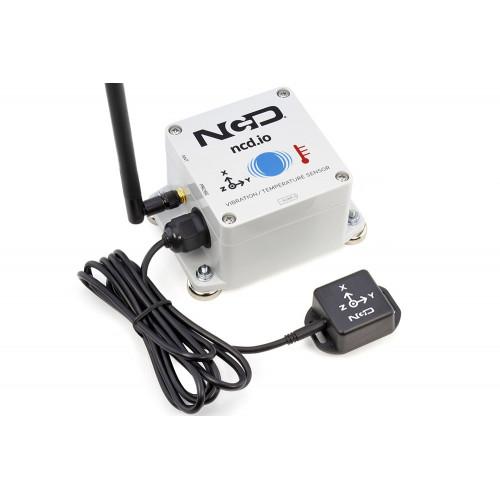Global Wireless Vibration Sensors market is projected to reach USD 1637.14 million in 2033, increasing from USD 864.53 million in 2023, with the CAGR of 6.6% during the period of 2024 to 2033.
Introduction to Wireless Vibration Sensors:
- Evolution of Vibration Monitoring: Wireless Vibration Sensors represent a transformative leap in the field of industrial monitoring, replacing traditional wired setups with more flexible and cost-effective wireless solutions.
- Monitoring Critical Machinery: Designed for real-time monitoring of vibration levels in machinery, these sensors provide crucial insights into the health and performance of industrial equipment.
Key Technological Aspects:
- Wireless Connectivity: Utilizing wireless communication protocols such as Bluetooth, Zigbee, and Wi-Fi, these sensors offer the advantage of easy installation and scalability, eliminating the need for complex wiring infrastructure.
- Sensitivity and Precision: Advanced sensor technologies enable high sensitivity, ensuring accurate detection of even minor vibrations, helping prevent equipment failures and downtime.
- Battery Efficiency: Efficient power management and low-power consumption technologies prolong battery life, allowing for extended sensor operation without frequent replacements.
Applications in Industrial Settings:
- Predictive Maintenance: A cornerstone application, Wireless Vibration Sensors enable predictive maintenance strategies by continuously monitoring machinery. This leads to a reduction in unplanned downtime and prevents catastrophic failures.
- Condition Monitoring: Industries such as manufacturing, oil and gas, and utilities leverage these sensors for real-time condition monitoring, ensuring optimal performance and safety of critical equipment.
- Asset Health Management: Beyond vibration monitoring, these sensors contribute to overall asset health management by collecting data on temperature, humidity, and other environmental factors.
Advantages Over Wired Alternatives:
- Flexibility and Scalability: Wireless Vibration Sensors offer unparalleled flexibility, allowing easy relocation and adaptation to changing monitoring needs. Scalability is achieved without the constraints of physical wiring, facilitating cost-effective deployment in large industrial facilities.
- Reduced Installation Costs: Eliminating the need for extensive wiring reduces installation costs significantly, making wireless solutions more economical, especially in retrofitting existing infrastructure.
- Ease of Integration: Wireless sensors seamlessly integrate with existing Industrial Internet of Things (IIoT) ecosystems, supporting a connected and data-driven approach to industrial operations.
Receive the FREE Sample Report of Wireless Vibration Sensors Market Research Insights @ https://stringentdatalytics.com/sample-request/wireless-vibration-sensors-market/7807/
Market Segmentations:
Global Wireless Vibration Sensors Market: By Company
• Baker Hughes
• TE Connectivity
• Valmet
• Shinkawa Electric
• ABB
• Emerson
• Yokogawa
• Erbessd Instruments
• Banner Engineering
• Ifm
• SPM Instrument
• NI
• Acoem
• Advantech
• Fluke
• Sumyoung Tech
Global Wireless Vibration Sensors Market: By Type
• Short-range Wireless Technology
• LPWAN Technology
Global Wireless Vibration Sensors Market: By Application
• Manufacturing
• Automotive
• Energy and Power
• Oil and Gas
• Metals and Mining
• Chemicals
• Others
Regional Analysis of Global Wireless Vibration Sensors Market
All the regional segmentation has been studied based on recent and future trends, and the market is forecasted throughout the prediction period. The countries covered in the regional analysis of the Global Wireless Vibration Sensors market report are U.S., Canada, and Mexico in North America, Germany, France, U.K., Russia, Italy, Spain, Turkey, Netherlands, Switzerland, Belgium, and Rest of Europe in Europe, Singapore, Malaysia, Australia, Thailand, Indonesia, Philippines, China, Japan, India, South Korea, Rest of Asia-Pacific (APAC) in the Asia-Pacific (APAC), Saudi Arabia, U.A.E, South Africa, Egypt, Israel, Rest of Middle East and Africa (MEA) as a part of Middle East and Africa (MEA), and Argentina, Brazil, and Rest of South America as part of South America.
Click to Purchase Wireless Vibration Sensors Market Research Report @ https://stringentdatalytics.com/purchase/wireless-vibration-sensors-market/7807/
Industry-Specific Implementations:
- Manufacturing: In manufacturing plants, Wireless Vibration Sensors enhance equipment efficiency by identifying abnormalities in rotating machinery, ensuring timely maintenance to prevent costly breakdowns.
- Oil and Gas: Deployed in remote and challenging environments, these sensors provide real-time monitoring of critical equipment in the oil and gas industry, reducing downtime and improving worker safety.
- Utilities: Power plants and utilities leverage wireless sensors for monitoring turbines, generators, and other rotating equipment, optimizing asset performance and extending operational lifespans.
Market Growth Drivers:
- Industry 4.0 Adoption: As industries embrace the fourth industrial revolution, the adoption of smart technologies, including Wireless Vibration Sensors, accelerates, driving market growth.
- Focus on Preventive Maintenance: The paradigm shift towards preventive maintenance strategies fosters demand for continuous monitoring solutions, positioning wireless vibration sensors as essential tools for proactive asset management.
- Cost Savings and Efficiency Gains: The promise of cost savings through reduced downtime and increased operational efficiency is a significant driver for industries seeking to optimize maintenance practices.
Challenges and Solutions:
- Security Concerns: Wireless networks pose security challenges, but encryption and secure communication protocols are continually improving, addressing concerns and making wireless sensor networks more robust.
- Interference and Signal Strength: Overcoming interference and maintaining signal strength in complex industrial environments require strategic placement of sensors and advancements in wireless communication technologies.
Innovations in Sensor Technology:
- Edge Computing Integration: Wireless Vibration Sensors increasingly incorporate edge computing capabilities, enabling on-site data processing. This reduces the need for constant data transmission, addressing bandwidth constraints and enhancing real-time analytics.
- Machine Learning Integration: Integration with machine learning algorithms enhances the diagnostic capabilities of wireless sensors, enabling predictive analysis and early detection of equipment anomalies.
Global Market Presence:
- Regional Adoption Trends: The adoption of Wireless Vibration Sensors varies across regions, with developed industrial economies leading in implementation. Emerging economies are witnessing increased adoption as industries modernize and invest in smart technologies.
- Competitive Landscape: Major players in the market include established sensor manufacturers, IoT solution providers, and industrial automation companies. The competitive landscape is evolving as new entrants bring innovative solutions to market.
Environmental and Sustainability Impact:
- Reduced Environmental Footprint: The elimination of extensive wiring not only reduces installation costs but also contributes to a smaller environmental footprint by minimizing the need for raw materials used in traditional wired sensor installations.
- Energy Efficiency: Wireless Vibration Sensors with optimized power consumption contribute to energy efficiency, supporting sustainability goals by prolonging battery life and reducing overall energy consumption.
Future Trends and Market Outlook:
- Integration with Cloud Platforms: Increasing integration with cloud-based platforms allows for centralized data storage, analysis, and access, enhancing the scalability and accessibility of wireless vibration monitoring solutions.
- Advancements in Battery Technology: Continued advancements in battery technology, including the use of rechargeable batteries and energy harvesting solutions, will further extend the operational life of wireless sensors.
- Customized Industry Solutions: The market is expected to witness the development of more specialized and industry-tailored wireless vibration sensor solutions to address specific challenges in diverse industrial sectors.
About Stringent Datalytics
Stringent Datalytics offers both custom and syndicated market research reports. Custom market research reports are tailored to a specific client’s needs and requirements. These reports provide unique insights into a particular industry or market segment and can help businesses make informed decisions about their strategies and operations.
Syndicated market research reports, on the other hand, are pre-existing reports that are available for purchase by multiple clients. These reports are often produced on a regular basis, such as annually or quarterly, and cover a broad range of industries and market segments. Syndicated reports provide clients with insights into industry trends, market sizes, and competitive landscapes. By offering both custom and syndicated reports, Stringent Datalytics can provide clients with a range of market research solutions that can be customized to their specific needs.
Reach US
Stringent Datalytics
+1 346 666 6655
Social Channels:




Leave a Reply